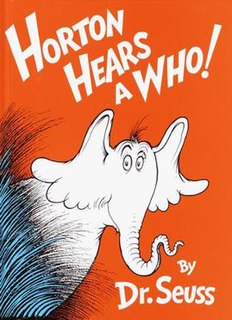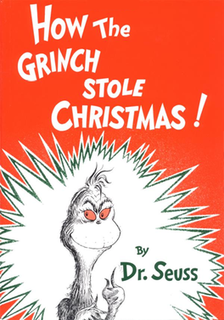
Theodor Seuss "Ted" Geisel was an American children's author, political cartoonist, illustrator, poet, animator, screenwriter, and filmmaker. He is known for his work writing and illustrating more than 60 books under the pen name Dr. Seuss (,). His work includes many of the most popular children's books of all time, selling over 600 million copies and being translated into more than 20 languages by the time of his death.

The Cat in the Hat is a children's book written and illustrated by Theodor Geisel under the pen name Dr. Seuss and first published in 1957. The story centers on a tall anthropomorphic cat who wears a red and white-striped hat and a red bow tie. The Cat shows up at the house of Sally and her brother one rainy day when their mother is away. Despite the repeated objections of the children's fish, the Cat shows the children a few of his tricks in an attempt to entertain them. In the process, he and his companions, Thing One and Thing Two wreck the house. The children and the fish become more and more alarmed until the Cat produces a machine that he uses to clean everything up and disappears just before the children's mother comes home.

Horton Hears a Who! is a children's book written and illustrated by Theodor Seuss Geisel under the pen name Dr. Seuss and was published in 1954 by Random House.

The Cat in the Hat Comes Back is a children's book written and illustrated by Dr. Seuss and published by Random House in 1958. The book is a sequel to The Cat in the Hat.

Horton Hatches the Egg is a children's book written and illustrated by Theodor Geisel under the pen name Dr. Seuss and published in 1940 by Random House. The book tells the story of Horton the Elephant, who is tricked into sitting on a bird's egg while its mother, Mayzie, takes a permanent vacation to Palm Beach. Horton endures a number of hardships but persists, often stating, "I meant what I said, and I said what I meant. An elephant's faithful, one hundred percent!" Ultimately, the egg hatches, revealing an elephant-bird, a creature with a blend of Mayzie's and Horton's features.

And to Think That I Saw It on Mulberry Street is Theodor Seuss Geisel's first children's book published under the pen name Dr. Seuss. First published by Vanguard Press in 1937, the story follows a boy named Marco, who describes a parade of imaginary people and vehicles traveling along a road, Mulberry Street, in an elaborate fantasy story he dreams up to tell his father at the end of his walk. However, when he arrives home he decides instead to tell his father what he actually saw—a simple horse and wagon.

The Seven Lady Godivas: The True Facts Concerning History's Barest Family is a picture book of the tale of Lady Godiva, written and illustrated by Dr. Seuss. One of Seuss's few books written for adults, its original 1939 publication by Random House was a failure and was eventually remaindered. However, it later gained popularity as Seuss himself grew in fame, and was republished in 1987.

McElligot's Pool is a children's book written and illustrated by Theodor Geisel under the pen name Dr. Seuss and published by Random House in 1947. In the story, a boy named Marco, who first appeared in Geisel's 1937 book And to Think That I Saw It on Mulberry Street, imagines a wide variety of strange fish that could be swimming in the pond in which he is fishing.

Beginner Books is the Random House imprint for young children ages 3–9, co-founded by Phyllis Cerf with Ted Geisel, more often known as Dr. Seuss, and his wife Helen Palmer Geisel. Their first book was Dr. Seuss's The Cat in the Hat (1957). Cerf compiled a list of 379 words as the basic vocabulary for young readers, along with another 20 slightly harder "emergency" words. No more than 200 words were taken from that list to write The Cat in the Hat. Subsequent books in the series were modeled on the same requirement.

Mr. Brown Can Moo! Can You?: Dr. Seuss's Book of Wonderful Noises! is a children's book written and illustrated by Theodor Geisel under the pen name Dr. Seuss and published by Random House in 1970.
Your Job In Germany is a short film made for the United States War Department in 1945 just before Victory in Europe Day (VE). It was shown to US soldiers about to go on occupation duty in Germany. The film was made by the military film unit commanded by Frank Capra and was written by Theodor Geisel, better known by his pen name Dr. Seuss.

Our Job in Japan was a United States military training film made in 1945, shortly after World War II. It is the companion to the more famous Your Job In Germany. The film was aimed at American troops about to go to Japan to participate in the 1945–1952 Allied occupation, and presents the problem of turning the militarist state into a peaceful democracy. The film focused on the Japanese military officials who had used the traditional religion of Shinto, as well as the educational system, to take over power, control the populace, and wage aggressive war.
Helen Marion Palmer Geisel, known professionally as Helen Palmer, was an American children's author, editor, and philanthropist. She was married to fellow author Theodor Seuss Geisel, better known as Dr. Seuss, from 1927 until her death. Her best-known books include Do You Know What I'm Going to Do Next Saturday?, I Was Kissed by a Seal at the Zoo, Why I Built the Boogle House, and A Fish Out Of Water.
Bartholomew Cubbins is a fictional page and the hero of two children's books by Dr. Seuss: The 500 Hats of Bartholomew Cubbins (1938) and Bartholomew and the Oobleck (1949). Besides the two books about him—and the stage adaptations of them—Bartholomew Cubbins also appears as a character in the TV show The Wubbulous World of Dr. Seuss. Seuss's only film, The 5,000 Fingers of Dr. T., has a main character named Bartholomew Collins, who, like his namesake, is a young boy who is wiser than the adults around him.
Design for Death is a 1947 American documentary film that won the Academy Award for Best Documentary Feature. It was based on a shorter U.S. Army training film, Our Job in Japan, that had been produced in 1945–1946 for the soldiers occupying Japan after World War II. Both films dealt with Japanese culture and the origins of the war.

How the Grinch Stole Christmas! is a children's story by Theodor "Dr. Seuss" Geisel written in rhymed verse with illustrations by the author. It follows the Grinch, a grumpy, solitary creature who attempts to put an end to Christmas by stealing Christmas-themed items from the homes of the nearby town Whoville on Christmas Eve. Miraculously, the Grinch realizes that Christmas may not all be about money and presents.
Theodor Seuss Geisel, better known as Dr. Seuss, published over 60 children's books over the course of his long career. Though most were published under his well-known pseudonym, Dr. Seuss, he also authored over a dozen books as Theo. LeSieg and one as Rosetta Stone. As one of the most popular children's authors of all time, Geisel's books have topped many bestseller lists, sold over 222 million copies, and been translated into more than 15 languages. In 2000, when Publishers Weekly compiled their list of the best-selling children's books of all time; 16 of the top 100 hardcover books were written by Geisel, including Green Eggs and Ham, at number 4, The Cat in the Hat, at number 9, and One Fish Two Fish Red Fish Blue Fish, at number 13, and Dr. Seuss's ABC. In the years following his death in 1991, several additional books based on his sketches and notes were published, including Hooray for Diffendoofer Day! and Daisy-Head Mayzie. Although they were all published under the name Dr. Seuss, only My Many Colored Days, originally written in 1973, was entirely by Geisel.

The Bippolo Seed and Other Lost Stories is a collection of seven illustrated stories by children's author Dr. Seuss published by Random House on September 27, 2011. Though they were originally published in magazines in the early 1950s, they had never been published in book form and are quite rare, described by the publisher as "the literary equivalent of buried treasure". The stories were discovered by Charles D. Cohen, a Massachusetts dentist and a Seuss scholar and biographer, who also contributed an introduction to the collection.

What Pet Should I Get? is a Dr. Seuss children's book, posthumously published in 2015. Believed to have been written between 1958 and 1962, the book chronicles the adventures of Jay and Kay from Seuss' One Fish, Two Fish, Red Fish, Blue Fish in their attempts to buy a pet.

Horse Museum is a Dr. Seuss book released by Random House Children's Books on September 3, 2019. It is based on an unfinished manuscript by Theodor Seuss Geisel completed by Australian illustrator Andrew Joyner. 250,000 copies were released of the first printing.















